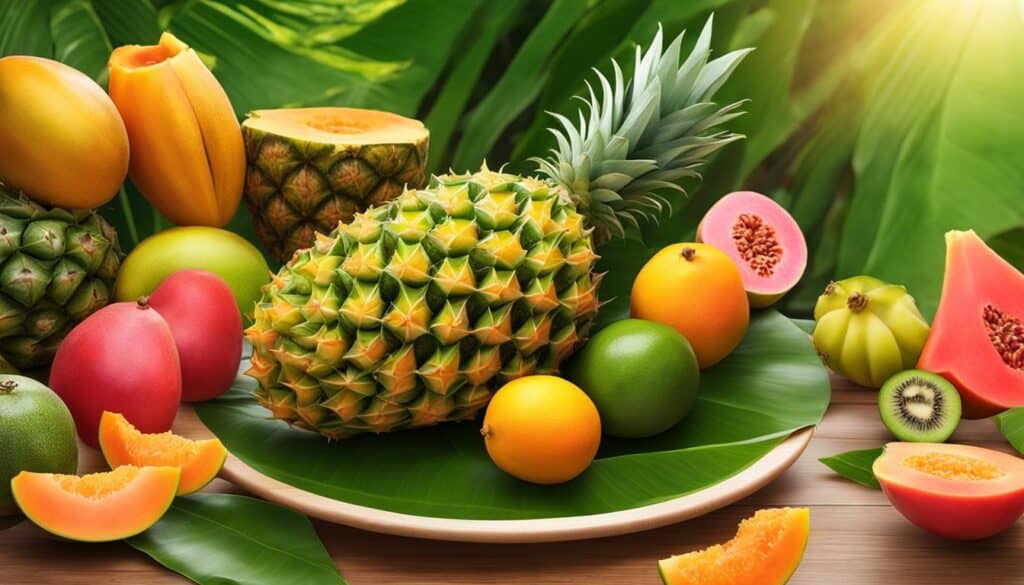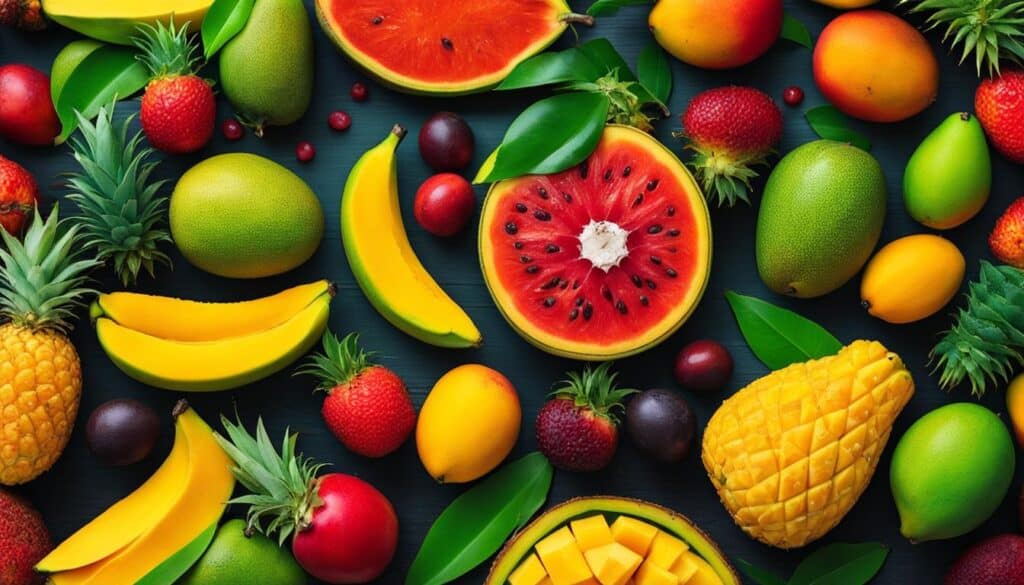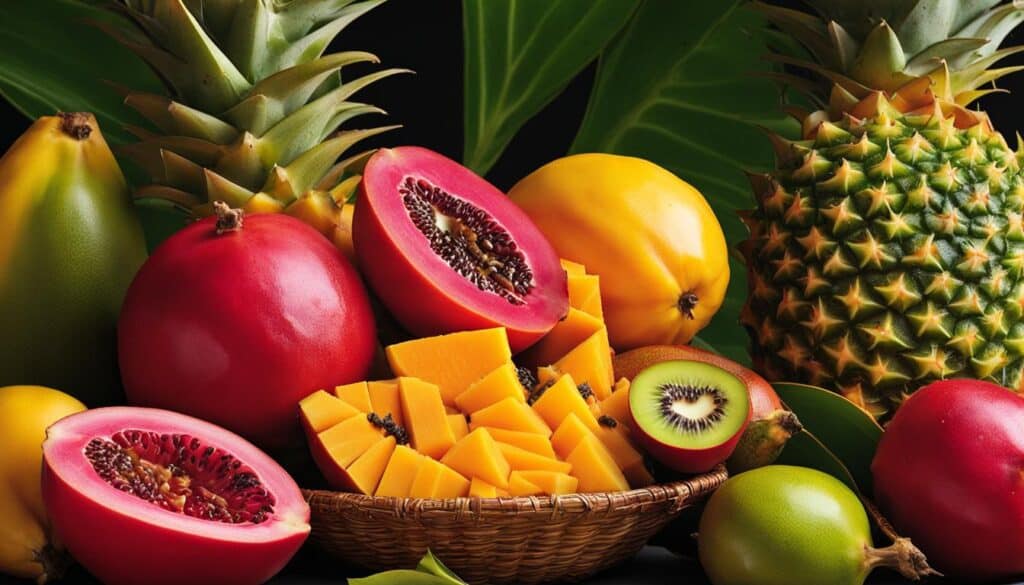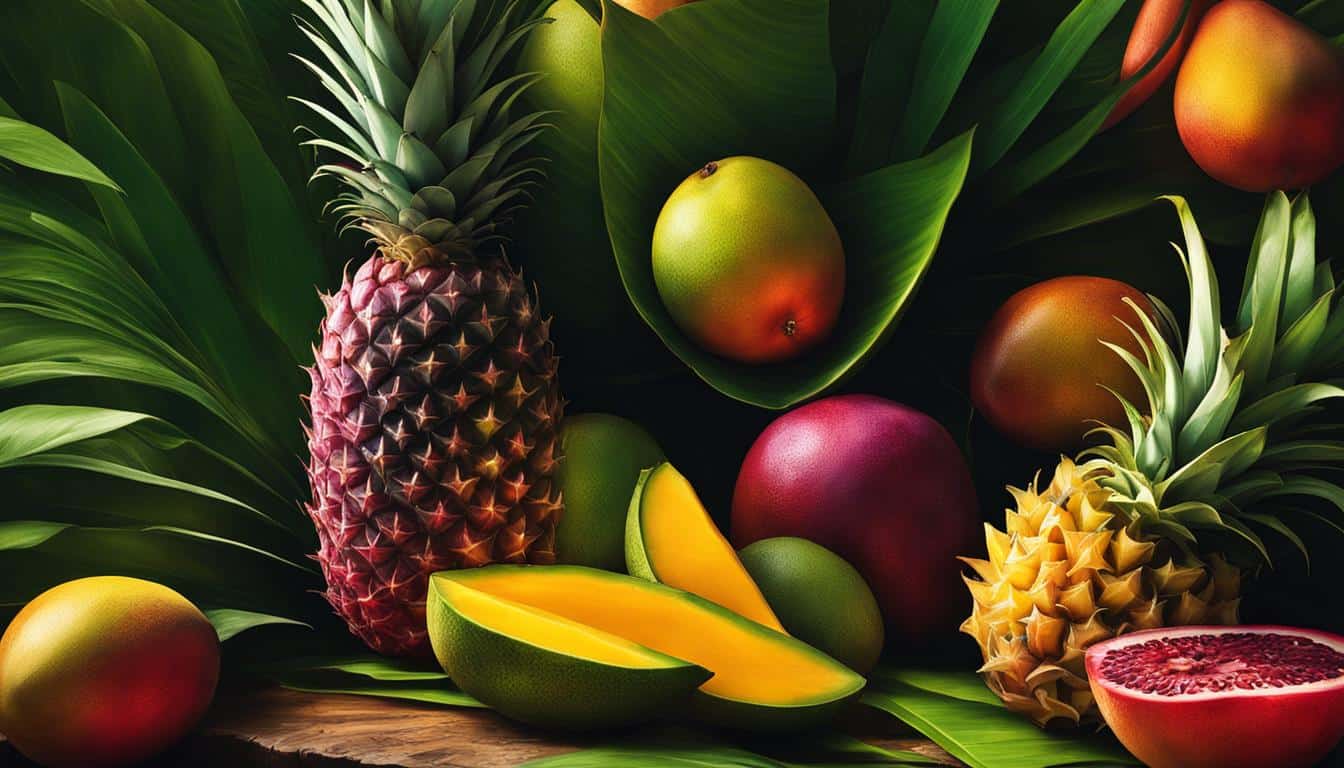Mango, with its sweet and juicy flavor, is a beloved tropical fruit that has earned the title of the “king of fruits.” But did you know that there are other exotic fruits that offer a similar tropical taste? Join me on a delightful journey as we explore a world of fruits that are just as delicious and satisfying as mango.
From the tangy guava to the exotic rambutan, these tropical fruits will transport your taste buds to a sunny paradise. Not only do they offer a wide range of flavors and textures, but they also come with their own unique health benefits. Whether you’re looking to add some tropical flair to your culinary creations or simply enjoy a healthy and refreshing snack, these fruits are sure to impress.
Join me as we delve into the diverse world of tropical fruits, from exploring different mango varieties to discovering mouth-watering mango recipes. Let’s unlock the secrets of these delicious fruits and embrace a tropical taste adventure.
Key Takeaways:
- There are other exotic fruits that offer a tropical taste similar to mango.
- Tropical fruits come in a variety of flavors and textures.
- Exploring different mango varieties allows you to experience a wide range of flavors.
- Mango is not only delicious but also packed with nutritional benefits.
- From sweet to savory, mango can be used in a variety of delicious recipes.
The Delightful World of Tropical Fruits
Tropical fruits are a vibrant and diverse category of fruits that grow in regions near the equator. They are known for their bright colors, unique shapes, and delicious flavors. Some common tropical fruits include pineapple, coconut, papaya, and bananas, but there are many more lesser-known fruits that deserve attention. These fruits, like mango, offer a taste of the tropics and can elevate your culinary experiences with their enticing flavors and nutritional benefits.
One of the most popular tropical fruits is pineapple. With its juicy and tangy flavor, pineapple is a versatile fruit that can be used in both sweet and savory dishes. It adds a tropical twist to smoothies, salads, and even grilled meats. Coconut, on the other hand, is a tropical fruit known for its rich and creamy texture. It is often used in desserts, such as coconut cream pie and coconut macaroons, as well as in savory dishes like curries and rice dishes.
Papaya, with its vibrant orange flesh and sweet taste, is another beloved tropical fruit. It is commonly enjoyed fresh, but it can also be used in salads, salsas, and smoothies. Bananas, although a more familiar fruit, are also considered tropical. They are packed with potassium and are a great source of energy. Bananas can be eaten on their own, added to smoothies, or used in baked goods like banana bread.
| Tropical Fruit | Flavor | Uses |
|---|---|---|
| Pineapple | Tangy and sweet | Smoothies, salads, grilled dishes |
| Coconut | Creamy and nutty | Desserts, curries, rice dishes |
| Papaya | Sweet and tropical | Fresh, salads, salsas, smoothies |
| Banana | Sweet and creamy | On its own, smoothies, baked goods |
These are just a few examples of the delightful tropical fruits that are available. Whether you’re looking for a refreshing snack, a flavorful addition to your recipes, or a tropical twist to your menu, exploring the world of tropical fruits like mango can open up a whole new world of culinary possibilities.
Mango Varieties: Exploring the Mango Family

When it comes to mangoes, there is a world of variety waiting to be discovered. From sweet and buttery to tangy and tropical, each mango variety offers a unique flavor experience. Let’s explore some of the most popular mango varieties and get to know the different characteristics they bring to the table.
Alphonso Mango
The Alphonso mango is often considered the king of mangoes, known for its superior taste and aroma. This variety has a rich, creamy texture and a sweet, floral flavor with hints of citrus. Alphonso mangoes are primarily grown in India and are sought after for their exceptional quality.
Kent Mango
The Kent mango is a large, oval-shaped mango with a sweet and rich flavor. It has a smooth, fiber-less flesh that melts in your mouth. Kent mangoes are widely available and are known for their vibrant orange-yellow skin. They are a popular choice for fresh consumption and are often used in desserts and smoothies.
Ataulfo Mango
The Ataulfo mango, also known as the Champagne mango, is small and yellow in color. It has a creamy, buttery texture and a sweet, tropical flavor with hints of honey. Ataulfo mangoes are native to Mexico and are highly prized for their unique taste and smooth flesh. They are often used in salsas, salads, and desserts.
Tommy Atkins Mango
The Tommy Atkins mango is one of the most widely grown mango varieties in the world. It has a vibrant red and green skin and a mild, slightly tart flavor. Tommy Atkins mangoes have firm flesh and are known for their excellent shelf life. While they may not have the same sweetness as other varieties, they are still a popular choice for cooking and juicing.
These are just a few examples of the many mango varieties that exist. Each variety has its own unique taste, texture, and appearance, making mangoes a truly versatile fruit. Whether you prefer the sweetness of the Alphonso mango or the tanginess of the Tommy Atkins mango, there is a mango variety out there to suit every palate.
| Mango Variety | Flavor | Texture | Origin |
|---|---|---|---|
| Alphonso | Sweet, floral, citrusy | Creamy | India |
| Kent | Sweet, rich | Smooth, fiber-less | Various |
| Ataulfo | Sweet, tropical, honey-like | Creamy, buttery | Mexico |
| Tommy Atkins | Mild, slightly tart | Firm | Various |
The Benefits of Mango: More Than Just a Delicious Fruit
Mango is not only a delicious fruit but also a nutritious one. It is packed with vitamins, minerals, and antioxidants that contribute to overall health and well-being. Here are some of the key benefits of incorporating mango into your diet:
- Supports Heart Health: Mangoes are rich in potassium, which helps maintain healthy blood pressure levels. They also contain fiber and antioxidants that can reduce the risk of heart disease.
- Boosts Immunity: With their high vitamin C content, mangoes can help strengthen the immune system and protect against infections and illnesses.
- Aids Digestion: Mangoes are a good source of dietary fiber, which promotes healthy digestion and prevents constipation. They also contain enzymes that aid in the breakdown of proteins, making them easier to digest.
- Improves Skin Health: The antioxidants and vitamins found in mangoes can help improve the health and appearance of your skin. They can reduce signs of aging, promote a youthful glow, and even help heal wounds.
- Promotes Eye Health: Mangoes are rich in beta-carotene, which the body converts into vitamin A. This nutrient is essential for good vision and can help prevent age-related macular degeneration.
“Mango is a versatile fruit that not only satisfies your taste buds but also provides numerous health benefits.”
Whether you enjoy mango on its own, in smoothies, or as an ingredient in various dishes, you can reap the health benefits of this tropical fruit. Its delicious taste and nutritional value make it a great addition to a healthy and balanced diet.
Mouth-Watering Mango Recipes: From Sweet to Savory

Mango, with its sweet and juicy flavor, is a versatile fruit that can be used in a variety of mouth-watering recipes. Whether you’re in the mood for something sweet or savory, mango can add a delightful tropical twist to your favorite dishes. From refreshing smoothies and tropical fruit salads to tangy salsas and spicy curries, there are endless possibilities when it comes to cooking with mango.
To inspire your culinary creativity, here are a few delicious mango recipes to try:
1. Mango Salsa
Combine diced mango, red onion, jalapeno, cilantro, lime juice, and a pinch of salt for a refreshing and tangy salsa. Serve it with tortilla chips or use it as a topping for grilled fish or chicken.
2. Mango Coconut Chia Pudding
In a jar, mix chia seeds, coconut milk, and diced mango. Let it sit in the refrigerator overnight to allow the chia seeds to absorb the liquid. In the morning, you’ll have a delicious and nutritious breakfast pudding.
3. Mango Sticky Rice
Cook sticky rice according to package instructions. Serve it with ripe mango slices and a drizzle of sweet coconut sauce for a traditional Thai dessert that will transport you to the tropics.
4. Grilled Mango with Chili and Lime
Brush mango slices with a mixture of chili powder, lime juice, and honey. Grill the mango until lightly charred and caramelized. Serve it as a side dish or as a topping for grilled meats or salads.
These recipes are just a starting point to explore the deliciousness of mango. Feel free to experiment and add your own twist to create unique dishes that highlight the tropical flavors of this wonderful fruit. So, go ahead and indulge in the mouth-watering world of mango recipes!
| Recipe | Ingredients | Instructions |
|---|---|---|
| Mango Salsa | Diced mango, red onion, jalapeno, cilantro, lime juice, salt | Combine all ingredients in a bowl and mix well. Serve as a dip or topping. |
| Mango Coconut Chia Pudding | Chia seeds, coconut milk, diced mango | In a jar, mix chia seeds, coconut milk, and diced mango. Refrigerate overnight and enjoy. |
| Mango Sticky Rice | Sticky rice, ripe mango, sweet coconut sauce | Cook sticky rice and serve with mango slices and a drizzle of sweet coconut sauce. |
| Grilled Mango with Chili and Lime | Mango slices, chili powder, lime juice, honey | Brush mango slices with chili powder, lime juice, and honey. Grill until caramelized. |
Exploring Other Delicious Tropical Fruits

Aside from mango, there are numerous other tropical fruits that are worth exploring. Each of these fruits offers a unique flavor and texture that can transport you to a tropical paradise. Some of these delicious fruits include:
- Guava: Known for its sweet and tangy flavor, guava is often used in juices and desserts. It adds a refreshing and tropical twist to any dish.
- Passion Fruit: With its unique tartness, passion fruit is a popular ingredient in cocktails and desserts. The vibrant orange color and tangy flavor make it a crowd pleaser.
- Jackfruit: This tropical fruit has a meat-like texture and a sweet taste. It is often used as a vegan substitute for pulled pork and adds a tropical twist to savory dishes.
- Rambutan: With its lychee-like taste and spiky exterior, rambutan is a delightful tropical treat. The juicy flesh and sweet flavor make it a favorite among fruit enthusiasts.
These tropical fruits can be enjoyed on their own or incorporated into a variety of dishes. From refreshing smoothies and fruit salads to exotic desserts and savory recipes, the possibilities are endless when it comes to cooking with these delicious fruits.
Try using guava in a tropical fruit salsa, passion fruit in a tangy vinaigrette, jackfruit in a flavorful curry, or rambutan in a refreshing fruit salad. These fruits are not only delicious, but they also add a touch of tropical elegance to any meal.
So, if you’re looking to expand your culinary horizons and experience the delightful flavors of the tropics, don’t just stop at mango. Explore the wide variety of delicious tropical fruits available and let your taste buds embark on a tropical taste adventure.
The Importance of Properly Washing and Preparing Tropical Fruits

When it comes to enjoying tropical fruits like mango and others, proper washing and preparation are essential for food safety. These fruits, being exposed to various contaminants during growing and handling processes, require thorough cleaning before consumption. By following a few simple steps, you can ensure that you’re enjoying your tropical fruits in the safest and most delicious way possible.
Washing Tropical Fruits
To begin, wash your tropical fruits under running water to remove any dirt or bacteria on the surface. Using a vegetable brush, gently scrub the fruits to remove any stubborn residue. This step is particularly important for fruits with textured skin, such as pineapple or rambutan. Once washed, pat the fruits dry with a clean towel before cutting or peeling.
Proper Handling and Storage
In addition to washing, proper handling and storage techniques are crucial for maintaining the freshness of tropical fruits. After washing, store the fruits in a cool, dry place away from direct sunlight. Some fruits, like bananas, can be stored at room temperature while others, like mangoes, benefit from refrigeration. It’s important to note that once cut, tropical fruits should be stored in an airtight container in the refrigerator to prevent spoilage.
Enjoying Fresh and Delicious Tropical Fruits
With your tropical fruits properly washed and prepared, you’re ready to enjoy their fresh and delicious flavors. Whether you’re eating them as a snack, incorporating them into a recipe, or adding them to your restaurant’s menu, you can savor the tropical taste adventure with confidence knowing that you’ve taken the necessary steps to ensure their safety and quality.
Adding Tropical Fruits to Your Menu: A Culinary Adventure

If you own a restaurant or a juice/smoothie bar, incorporating tropical fruits into your menu can offer a unique and exciting culinary experience for your customers. From mango-centric dishes to exotic fruit smoothies and tropical fruit salads, there are endless possibilities for incorporating these fruits into your menu. Not only will tropical fruits add vibrant colors and flavors to your dishes, but they will also showcase your creativity and commitment to offering unique and delicious options to your customers.
One way to incorporate tropical fruits into your menu is by creating mango-inspired dishes. The sweet and juicy flavor of mango can be showcased in salads, desserts, and even savory dishes. For example, you can create a refreshing mango salsa to accompany grilled fish or use diced mango as a topping for a tropical fruit pizza. The possibilities are truly endless when it comes to incorporating mango into your menu.
In addition to mango, there are a variety of other tropical fruits that can elevate your menu. Consider creating exotic fruit smoothies using ingredients like pineapple, passion fruit, and guava. These tropical fruits offer unique flavors that can transport your customers to a tropical paradise with each sip. You can also experiment with tropical fruit salads, combining fruits like papaya, dragon fruit, and kiwi for a refreshing and colorful dish.
Table: Tropical Fruit Menu Ideas
| Menu Item | Description |
|---|---|
| Tropical Mango Salad | A refreshing salad featuring fresh mango, mixed greens, avocado, and a citrus vinaigrette. |
| Pineapple Ginger Smoothie | A tropical blend of pineapple, ginger, banana, and coconut milk, perfect for a refreshing drink. |
| Passion Fruit Cheesecake | A creamy cheesecake infused with the tart and tropical flavors of passion fruit. |
| Guava BBQ Glazed Ribs | Tender and juicy ribs glazed with a sweet and tangy guava barbecue sauce. |
| Tropical Fruit Platter | A colorful assortment of fresh tropical fruits, including papaya, dragon fruit, and kiwi. |
By incorporating tropical fruits into your menu, you can offer your customers a culinary adventure filled with exotic flavors and delightful taste experiences. Whether it’s a mango-inspired dish or a tropical fruit smoothie, these fruits will add a touch of excitement and freshness to your menu. So go ahead, embrace the tropical flavors, and let your customers indulge in the deliciousness of these delightful fruits.
Conclusion
In conclusion, exploring a world of tropical fruits like mango offers a delightful tropical taste adventure. These fruits, similar to mango, provide a wide range of flavors and textures that are sure to satisfy your taste buds. From the sweet and juicy taste of mango to the tartness of passion fruit and the unique meaty texture of jackfruit, each fruit offers a unique experience.
Not only are tropical fruits delicious, but they also offer numerous health benefits. Mango and other tropical fruits are rich in vitamins, minerals, and antioxidants, making them a great addition to a healthy diet. They can support heart health, boost immunity, aid digestion, improve skin health, and even promote eye health.
Whether you incorporate tropical fruits into your own diet or add them to your restaurant’s menu, these fruits can transport you to a tropical paradise. The vibrant colors, enticing flavors, and versatility of tropical fruits make them a great choice for any culinary adventure.
FAQ
What is mango?
Mango is a highly popular tropical fruit known for its sweet and juicy flavor.
Why is mango referred to as the “king of fruits”?
Mango is often referred to as the “king of fruits” due to its popularity and delicious taste.
Are there any other tropical fruits similar to mango?
Yes, there are many other exotic tropical fruits that offer a delightful tropical taste adventure, including guava, passion fruit, jackfruit, and rambutan.
What are some health benefits of mango?
Mango is rich in vitamins, minerals, and antioxidants, and it can support heart health, boost immunity, aid digestion, improve skin health, and promote eye health.
How can I incorporate mango into my cooking?
Mango is a versatile fruit that can be used in a variety of recipes, including smoothies, fruit salads, salsas, and curries.
What are some popular mango varieties?
Some popular mango varieties include Alphonso, Kent, Ataulfo, and Tommy Atkins, each with its own unique flavor profile, texture, and appearance.
How should I wash and prepare tropical fruits?
It is important to properly wash tropical fruits to ensure food safety. Washing with water and using a vegetable brush can remove any dirt or bacteria.
How can I add tropical fruits to my restaurant’s menu?
Incorporating tropical fruits into your menu can offer a unique and exciting culinary experience. You can use tropical fruits in dishes like mango-centric recipes, exotic fruit smoothies, and tropical fruit salads.





Leave a Reply